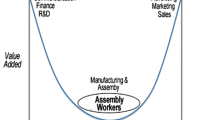Abstract
Many transnational corporations and international organizations have embraced corporate social responsibility (CSR) to address criticisms of working and environmental conditions at subcontractors’ factories. While CSR ‹codes of conduct’ are easy to draft, supplier compliance has been elusive. Even third-party monitoring has proven an incomplete solution. This article proposes that an alteration in the supply chain’s governance, from an arms-length market model to a collaborative partnership, often will be necessary to effectuate CSR. The market model forces contractors to focus on price and delivery as they compete for the lead firm’s business, rendering CSR observance secondary, at best. A collaborative partnership where the lead firm gives select suppliers secure product orders and other benefits removes disincentives and adds incentives for CSR compliance. In time, the suppliers’ CSR habit should shift their business philosophy toward pursuing CSR as an end in itself, regardless of buyer incentives and monitoring. This article examines these hypotheses in the context of the athletic footwear sector with Nike, Inc. and its suppliers as the specific case study. The data collected and conclusions reached offer strategies for advancing CSR beyond the superficial and often ineffectual ‹code of conduct’ stage.
Similar content being viewed by others
References
Ballinger, J. 1992. The New Free-Trade Heel, Harper’s Magazine. 285(1701): 46
Beder, S. 2002. Putting the Boot In. Ecologist 32(3): 24
Capaldi, N. 2005. Corporate Social Responsibility and the Bottom Line, International Journal of Social Economics 32(5): 408–423
Carty, V.: 1999, Emerging Post-Industrial, Postmodern Trends and the Implications for Social Change: A Case-Study of Nike Corporation (Ph.D. Department of Sociology: University of New Mexico)
Donaghu M. T., R. Barff: 1990. Nike Just Did it – International Subcontracting and Flexibility in Athletic Footwear Production. Regional Studies 24(6): 537–552
Frenkel, S. J. 2001. Globalization, Athletic Footwear Commodity Chains and Employment Relations in China, Organization Studies 22(4): 531–562
Gereffi, G.: 1994, ‹The Organisation of Buyer-Driven Global Commodity Chains: How U.S. Retailers Shape Overseas Production Networks’. In G. Gereffi and M. Korzeniewicz (eds.), Commodity Chains and Global Capitalism (Praeger Publishers, Westport, CT)
Gereffi, G.: 1999, ‹International Trade and Industrial Upgrading in the Apparel Commodity Chain’, Journal of International Economics 48(1), 37–70
Gereffi, G., J. Humphrey, T. Sturgeon: 2005. The Governance of Global Value Chains, Review of International Political Economy 12(1): 78–104
Gereffi, G. and M. Korzeniewicz: 1990, ‹Commodity Chains and Footwear Exports in the Semiperiphery’, in W. G. Martin (ed.), Semiperipheral States in the World-Economy (Greenwood Press, Westport, Connecticut)
Goldman, R., S. Papson: 2000. Nike Culture. London: Sage Publications Ltd.
Henderson J., P. Dicken, M. Hess, N. Coe, H. W. C. Yeung. 2002. Global Production Networks and the Analysis of Economic Development. Review of International Political Economy 9(3): 436–464
Humphrey, J. and H. Schmitz: 2004, ‹Chain Governance and Upgrading: Taking Stock’, in H. Schmitz (ed.), Local Enterprises in the Global Economy: Issues of Goverance and Upgrading (Edward Elgar Publishing Ltd., Cheltenham, UK)
Kahle L. R., D. M. Boush, M. Phelps: 2000, Good Morning, Vietnam: The Ethical Analysis of Nike Activities in Southeast Asia. Sports Marketing Quarterly 9(1): 43–52
Katz, D. 1994. Just Do It: The Nike Spirit in the Corporate World. Holbrok, MA: Adams Publishing
Korzeniewicz, M.: 1994, ‹Commodity Chains and Marketing Strategies: Nike and the Global Athletic Footwear Industry’, in G. Gereffi and M. Korzeniewicz (eds.), Commodity Chain and Global Capitalism (Praeger, Westport)
Lim, S.-J. 1997. The Political Economy of Orderly Marketing Agreements (1977–1981). Korea Journal of Population and Development 26(2): 79–99
Lipton, M.: 2001, ‹Comment’ (to Basu, Kaushik. “On the Goals of Development”), in G. Meier and J. E. Stiglitz (eds.), Frontiers of Development Economics: The Future in Perspective (Oxford University Press, New York)
Mackenzie, C. 2004. Moral Sanctions: Ethical Norms as a Solution to Corporate Governance Problems. Journal of Corporate Citizenship 15(Autumn): 49–61
Nikebiz.com: 2007, http://www.nike.com/nikebiz/nike biz.jhtml?page = 25&cat = monitoring; http://www. nike.com/nikebiz.jhtml?page25&cat = monitoring& subcate = shape; http://www.nike.com/nikebiz.jhml? page = 25&cat = monitoring&subcat = maudit; http:// www.nike.com/nikebiz/nikebiz.jhtml?page = 25&cat = monitoring&subcat = fla (accessed April 28, 2007)
Note: 2004, ‹Finding Strategic Corporate Citizenship: A New Game Theoretic View’, Harvard Law Review 117: 1957–1980
Rothenberg-Aalami, J.: 2002, Coming Full Circle?: Nike’s Production Networks in and Beyond Viet Nam. (Ph.D. Department of Geography, University of Oregon)
Rothenberg-Aalami, J. 2004, Coming Full Circle? Forging Missing Links Along Nike’s Integrated Production Networks. Global Networks 4(4): 335–354
Sage G. H. 1999. Justice Do It! The Nike Transnational Advocacy Network: Organization, Collective Actions, and Outcomes. Sociology of Sports Journal 16(3): 206–235
Schmidt, V. A.: 2005, ‹Institutionalism and the State’, in C. Hay, M. Lister and D. Marsh (eds.), The State: Theories and Issues (Palgrave MacMillan, Houndmills, England)
Shaw, R. 1999. Reclaiming America: Nike, Clean Air, and the New National Activism. Berkeley: University of California Press
Vanderbilt, T. 1998. The Sneaker Book. New York: The New Press
Vogel, D. 2005. The Market for Virtue: The Potential and Limits of Corporate Social Responsibility. Washington, D.C.: Brookings Institution Press
Wang, H.-Z. 2005. Asian Transnational Corporations and Labor Rights: Vietnamese Trade Unions in Taiwan-invested Companies. Journal of Business Ethics 56: 43–53
Zadeck, S. 2004. Path to Corporate Responsibility. Harvard Business Review 82(12): 125–132
Acknowledgment
This article was supported by Dong-A University Research Fund in 2007.
Author information
Authors and Affiliations
Corresponding author
Rights and permissions
About this article
Cite this article
Lim, SJ., Phillips, J. Embedding CSR Values: The Global Footwear Industry’s Evolving Governance Structure. J Bus Ethics 81, 143–156 (2008). https://doi.org/10.1007/s10551-007-9485-2
Received:
Accepted:
Published:
Issue Date:
DOI: https://doi.org/10.1007/s10551-007-9485-2




